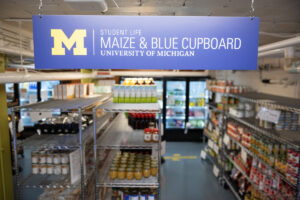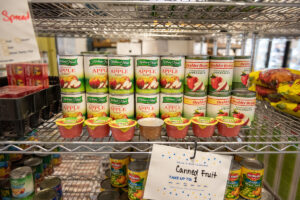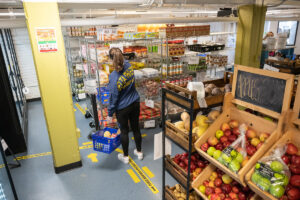Hungry for a good thing
We’ve all heard the axiom: “Give a man a fish, and he will eat for a day. Teach a man to fish, and he will eat for a lifetime.”
That’s all well and good, says Alex Bryan, BA ’07. “But it’s a lot easier to learn to fish if you’re not really hungry at the time.”
Bryan is manager of U-M’s Sustainable Food Program (UMSFP) and a longtime food justice advocate with experience in food banks and urban farming. “We can’t address the long term without dealing with the short term,” he says.
Hot topic

After years of operating as a mobile food distribution center, Maize & Blue Cupboard established a permanent footprint in Betsy Barbour Residence Hall. (Photo: Eric Bronson, Michigan Photography.)
Food insecurity is top of mind these days, thanks to the economic devastation wrought by COVID-19. Feeding America statistics show from the beginning of March 2020 through the end of June, food banks nationwide distributed more than 1.9 billion meals to people facing hunger in the United States.
“Prices are up, wages are down, and incomes are further stratifying,” says Trevor Bechtel, student engagement coordinator at U-M’s Poverty Solutions. He facilitates campus programs, events, and research opportunities to prevent and alleviate poverty.
Food insecurity is deceptive, he notes, and can affect people who live above, as well as below, the poverty line. It’s also a much bigger problem than we may think. A 2015 study by nutritional science researchers in the School of Public Health showed unprecedented high levels of food insecurity among respondents. And that was before COVID-19 came to town.
“Being a U-M student isn’t easy, especially during this pandemic,” says Savannah Redlinger, a senior in the School of Information. She relies on financial aid, works part-time, and lives off campus. “It’s even harder if you are struggling to pay rent and buy food. On top of that, you’re competing with students in classes who don’t have these worries.”
Mutual benefits
Poverty Solution’s Bechtel and UMSFP’s Bryan belong to a virtuous circle on campus designed to mitigate those worries. They advance knowledge, engage community, implement solutions, assess impacts, and share results — all while feeding students who may otherwise have gone hungry.Their virtuous circle includes the Campus Farm, Michigan Dining, and the Maize & Blue Cupboard, a free food pantry in the basement of the Betsy Barbour residence hall. Dining oversees the pantry, which opened its doors in 2019 after a few years roving the campus as a mobile distribution unit.
One telling metric this year: Despite the student exodus in March 2020 when the campus shut down, visits to the Maize & Blue Cupboard increased. In April 2019, the cupboard served 845 visitors; in 2020, that number had jumped to 1,282. In June 2020, 1,541 visitors came through, compared to 852 in 2019. September 2020 saw the highest number yet at 2,168.
Warming up
Attention to food insecurity started heating up in 2015, when School of Public Health doctoral student Nicole Kasper BS ’06/MPH ’09/PhD ’15, conducted a random survey of 2,000 U-M students about food insecurity. Kasper suspected it was a problem; she had experienced it herself as an undergrad. But even she was surprised by the results. Some 40 percent of respondents said they had experienced low to very low food security.
“No one believed it,” Kasper says. “People would say, ‘It’s U-M; it can’t be a big deal.”
But it is. In the years since that 2015 study, other researchers have found similar results, she says. According to the College & University Food Bank Alliance (CUFBA), some 30 percent of the nation’s college students are food insecure today. The U.S. Department of Agriculture defines food insecurity as a lack of consistent access to enough food for an active, healthy life.
Housing has a lot to do with it, Kasper found. Students living off campus, first-generation students, and international students are among the most impacted.
“Ironically, education is the best way to better yourself,” Kasper says. “But you need nutrition to get through the day.”
Kasper currently is developing a food studies program at Adams State University in Southern Colorado to further explore the environmental and economic aspects of food systems. She also teaches nutrition courses there.
Cindy Leung, an assistant professor at SPH, continues the research stream at U-M. In August 2020, the American Journal of Health Promotion published her study “Understanding the cumulative burden of basic needs insecurities: Associations with health and academic achievement among college students.”
Leung found that half of those who responded to her survey had experienced some level of food insecurity:
- Very low security 15.2%
- Low security 16.8%
- Marginal security 17.7%
- High security 50.3%
In addition to food insecurity, Leung and her team asked respondents about financial and housing insecurity. Results showed 11 percent of students experienced all three insecurities. Compared to fully secure students, students with all three insecurities were more likely to have anxiety and depression, fair/poor health (including higher BMI), and lower GPA.

Students share recipes and food demos so students understand how to prepare healthy, inexpensive dishes. (Photo: Eric Bronson, Michigan Photography.)
Transportation challenges and banking issues, typical for many students, can make it difficult to grocery shop or even use delivery services. Some students lack the budgeting and cooking skills to manage their finances and eat well. Still others have no idea services even exist to help them. They may be embarrassed by being “not rich at Michigan” and isolate, further exacerbating negative outcomes.
Informed by the research, the cupboard provides recipes and other cooking tips (often next to an exotic item like kolrabi, for example). A newsletter, video series, and video tutorials add to the effort.
Meanwhile, Poverty Solutions’ Bechtel and his team created the Basic Needs Portal, a one-stop shop that covers University resources regarding food, finance, health care, housing, and transportation. It also identifies critical incident support services if a student experiences sexual assault, bias, and more.
Hungry heart

Students serve students in the Maize & Blue Cupboard. Paid staffer Eden Blutstein is a senior. (Photo: Eric Bronson, Michigan Photography.)
On an unseasonably warm November afternoon, a sandwich board reading “Maize & Blue Cupboard” directs a line of students toward the basement of the Betsy Barbour residence hall. There they will enter one of the 640 food pantries CUFBA counts on college campuses nationwide.
Designed like a small grocery store, the cupboard allows students the dignity to select their own food from a variety of nonperishables and fresh produce. Student staff and student volunteers are the first faces visitors see. Meeting spaces and a kitchen are open for students interested in food work that may not be related to the cupboard. The site serves as a hub where students also can learn about other social and support services on campus.
“In my experience, the cupboard is a helpful resource that can provide tangible relief for students who are struggling,” says SI student Redlinger. “The lines this summer were very long.”
Circular approach

The nonprofit Food Gatherers sells product to the pantry at a significant discount. (Photo: Eric Bronson, Michigan Photography.)
The nonprofit Ann Arbor food bank Food Gatherers is a primary product supplier to the pantry (at a significant markdown). Michigan Dining regularly supplies inventory it no longer can use. And the Campus Farm has delivered some 1,937 pounds of produce to the cupboard just since April. In addition, the farm, launched in 2011, supplies produce to Michigan Dining, which purchases about $100,000 in produce annually. This arrangement also benefits students.
“Because [Dining] provides the farm with financial support, they are able to pay student staff, who in turn support the pantry,” says Steve Mangan, senior director of Michigan Dining. He is a longtime chef and culinarian. “That means students are growing food for other students. It’s a circular approach that works very well.”
Also, the salaried positions at the farm and the pantry offer options to students who can’t afford to volunteer.
“If we only allow those who can afford to take on the leadership roles [without pay], we are perpetuating the cycle that only those kids get leadership experience,” Mangan says.
The campus is a living lab, notes UMSFP’s Bryan. “Our goal is to center students in the experience so the services we provide are useful,” he says. “We want to put them in roles where they are doing the research or leading the work. When we can find ways to stack on real services with education and leadership development, that is a win, win, win.”
Conversation to impact
Students in the College of Engineering joined the effort this summer during a competitive COVID campus challenge. Some 14 teams chose food insecurity as their topic. Keith Soster, director of student engagement for Michigan Dining, says he’s borrowed at least one concept from each of the teams for implementation in the Maize & Blue Cupboard. The mobile distributions (pop-up food stands on North Campus), extended hours, and online reservation system all came from students. Volunteers also have marketing and promotion options; some present Food Savvy Fridays to offer news and strategies around food insecurity.“We have this data now to drive us toward very real solutions based on what students express as a need,” says Soster. “And we can do it in a way that honors the student vision.”
While it may be some time before comprehensive research exists to measure academic, economic, and health outcomes, Soster is confident the University is making an impact.
“We have a station where students can send ‘thank you cards’ to donors. To see a card filled with people talking about how grateful they are for this service is pretty cool.”
Feed a man for life

The Cupboard continues to serve the campus, even though it is technically “shut down.” (Photo: Eric Bronson, Michigan Photography.)
Michigan Dining initially funded Maize & Blue Cupboard in response to Kasper’s early research. Donors in the Division of Student Life established endowments that provide financial support for the pantry’s operations, but more funding is essential to its survival. Partners sometimes contribute personal care items and pots and pans. Primary dining vendor Gordon Food Services donates product regularly. In addition, the Center for the Education of Women, the Central Student Government, and the LSA and Rackham student governments are just some of the cupboard’s many campus partners. The Alumni Center and the Greek system have been boosters for volunteerism.
“The easiest thing would be to just give [students] free meals, but that doesn’t solve the problem,” Mangan says. “We hope that over time we can understand the issue at a deeper level and perhaps make some institutional change to help alleviate the problem.”
Something as simple as a financial aid food credit could make a significant difference, he says.
“I hope there might be some change in how financial aid works so food could be included in some of these awards out there,” Mangan says. “It’s hard to budget for food when all of your expenses are placed in one package that also includes rent, books, and computers.”
Till that happens, this virtuous circle on campus will continue to expand as more partners — researchers, students, staff, and alumni — seek to solve food insecurity at U-M.
“We have a saying at the cupboard,” Soster says. “If you don’t need the resource, be the resource.”
(Top image: Senior Eden Blutstein stocks the shelves at Maize & Blue Cupboard. Photo by Eric Bronson, Michigan Photography. This article was modified after publication to clarify that donors have established multiple endowments in Student Life to support the cupboard.)





Sue Rynski - 1977
It is wonderful that people are helping each other, that the spirit of community, service and assistance to those in need.
Without wanting to criticize, and knowing that UofM did not invent the euphemism, I am dismayed at the creation and usage of “Food Insecurity” to indicate the situation of people who can’t afford to buy food.
This term does not describe the real situation which is desastrous ; It glosses over and banalizes the stark reality.
“Food Insecurity” evokes foremost meaning food that is is not safe to eat.
Enough of these misleading euphemisms!
In my opinion.
Reply
Susan McLaughlin - 1993
Thank you for this article. The work the pantry is doing to address food insecurity among students is really inspiring. I would like to see the University make alumnae more aware of this wonderful initiative as a giving option.
Reply
Deborah Holdship
Tell your alumnae friends about the many ways they can support the cupboard by going to this link: https://mbc.studentlife.umich.edu/how-to-help/
Reply
Paul Hemmes - 1977
This is an amazing program uplifting, well conceived and developed. In this time of social unrest, this article has reinforced the notion that we do our best when we work together toward common goals and objectives. Hats off to University faculty and staff, students, and community food service organizations this wonderful collaboration! Go Blue, go Wolverines!
Reply
Jeff Griffin - 2002
Thank you for covering this little-seen but fast-growing challenge for students at Michigan and elsewhere.
Jack Griffin, Ross BBA ’19, grew FoodFinder while in Ann Arbor (and working closely with several of the organizations in this great article), and now helps food insecure people nationwide. Use of the FoodFinder app and website have quadrupled since the pandemic began, and has served hundreds of thousands of people in all 50 states.
If you know of anyone food insecure – anywhere in the US – please share FoodFinder with them so they can find help quickly and privately, closest to wherever they live. https://foodfinder.us
Reply
Robert Seidenstein - 1974
UM-Flint and UM-Dearborn have food pantries, too. A study at Flint reported 38 percent of students surveyed lacking basic food needs. I urge fellow grads to earmark a U of Michigan donation to a UM food pantry.
Reply